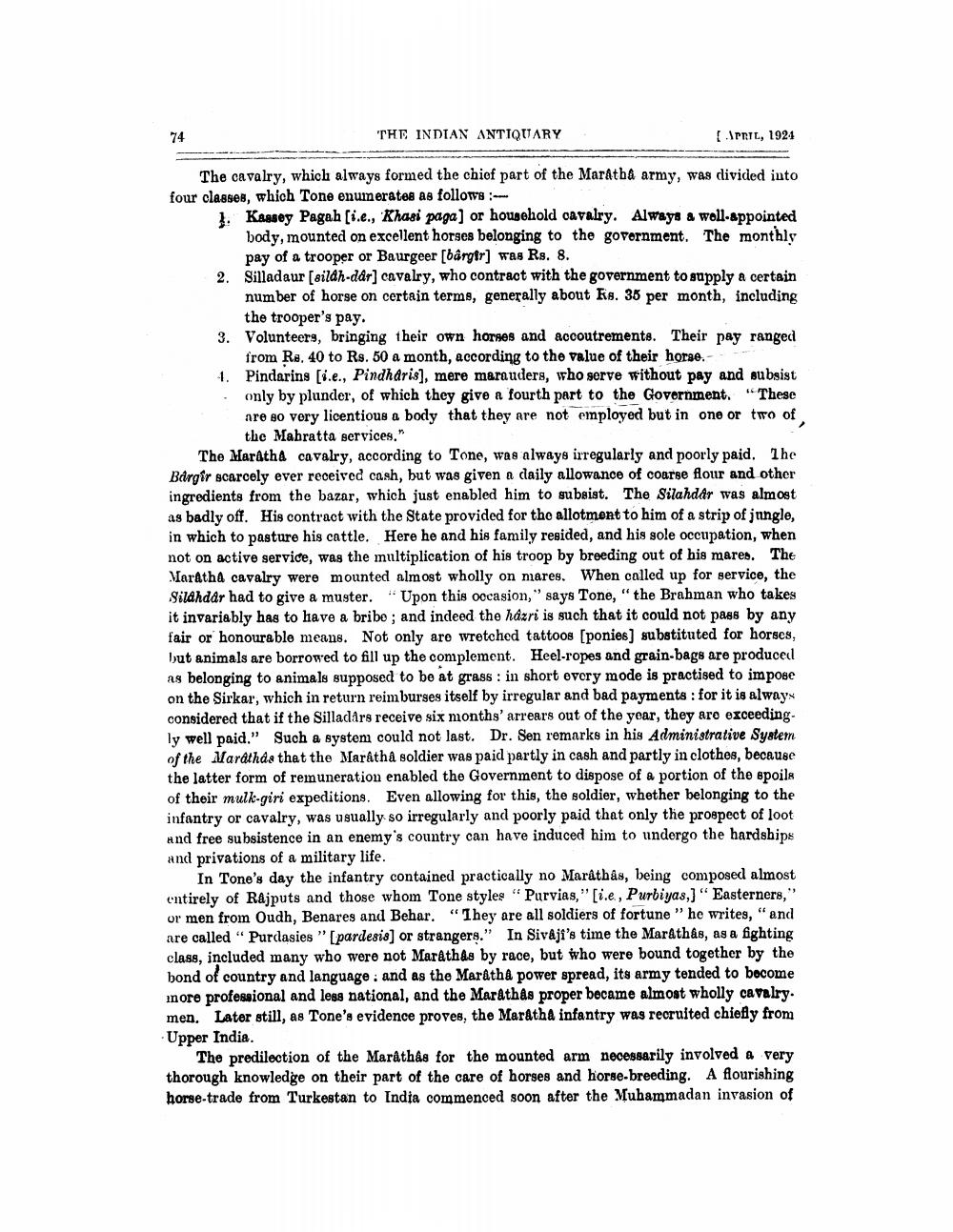________________
74
THE INDIAN ANTIQUARY
PRIL, 1924
The cavalry, which always formed the chief part of the Maratbá army, was divided into four classes, which Tone enuinerates as follows:
1. KAMOy Pagah i.e., Khasi paga) or household oavalry. Always a woll-appointed
body, mounted on excellent horses belonging to the government. The monthly
pay of a trooper or Baurgeer [bârgtr] was Rs. 8. 2. Silladaur (silah-dar] cavalry, who contract with the government to supply a certain
number of horse on certain terms, generally about Ks. 35 per month, including
the trooper's pay. 3. Volunteers, bringing their own horses and accoutrements. Their pay ranged
from Rs. 40 to Rs. 50 a month, according to the value of their horse. - 1. Pindarins [i.e., Pindharis], mere marauders, who serve without pay and subsist
only by plunder, of which they give a fourth part to the Government. These are so very licentious a body that they are not employed but in one or two of
the Mahratta services." The Maratha cavalry, according to Tone, was always irregularly and poorly paid. The Bargir scarcely ever received cash, but was given a daily allowance of coarse flour and other ingredients from the bazar, which just enabled him to subsist. The Silahdar was almost as badly off. His contract with the State provided for the allotment to him of a strip of jungle, in which to pasture his cattle. Here he and his family resided, and his sole occupation, when not on active service, was the multiplication of his troop by breeding out of his mares. The Maratha cavalry were mounted almost wholly on mares. When called up for service, the Silahdar had to give a muster. "Upon this occasion," says Tone, "the Brahman who takes it invariably has to have a bribe ; and indeed the hazri is such that it could not pass by any fair or honourable means. Not only are wretched tattoos (ponies] substituted for horses, but animals are borrowed to fill up the complement. Heel-ropes and grain-bags are produced as belonging to animals supposed to be at grass : in short every mode is practised to impose on the Sirkar, which in return reimburses itself by irregular and bad payments : for it is always considered that if the Silladars receive six months' arrears out of the year, they are exceeding. ly well paid." Such a system could not last. Dr. Sen remarks in his Administrative System of the Marathds that the Maratha soldier was paid partly in cash and partly in clothes, because the latter form of remuneration enabled the Government to dispose of a portion of the spoils of their mulk-giri expeditions. Even allowing for this, the soldier, whether belonging to the infantry or cavalry, was usually so irregularly and poorly paid that only the prospect of loot and free subsistence in an enemy's country can have induced him to undergo the hardships and privations of a military life.
In Tone's day the infantry contained practically no Marathâs, being composed almost entirely of Rajputs and those whom Tone styles "Purvias,"[i.e., Purbiyas,) "Easterners," or men from Oudh, Benares and Behar. "They are all soldiers of fortune" he writes, "and are called "Purdasies" (pardesis) or strangers." In Sivaji's time the Marath&s, as a fighting class, included many who were not Marathas by race, but who were bound together by the bond of country and language, and as the Maratha power spread, its army tended to become inore professional and legs national, and the Marathas proper became almost wholly cavalry. men. Later still, as Tone's evidence proves, the Maratha infantry was recruited chiefly from Upper India.
The predilection of the Marathas for the mounted arm necessarily involved a very thorough knowledge on their part of the care of horses and horse-breeding. A flourishing horse-trade from Turkestan to India commenced soon after the Muhammadan invasion of




